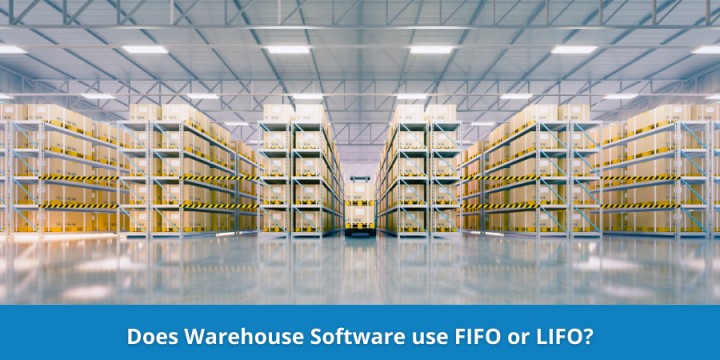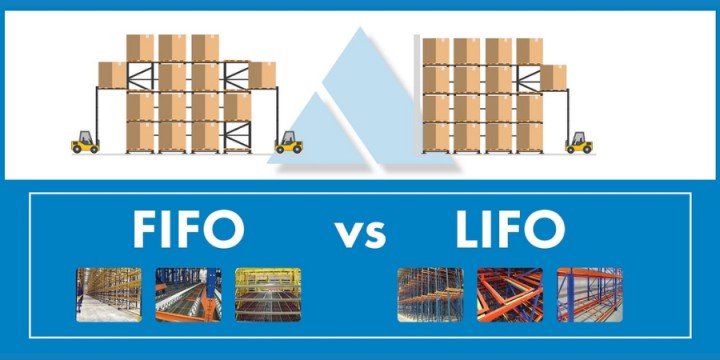Warehouse management is an integral component of the supply chain, and its seamless functioning ensures that goods reach the customers on time. By having a centralized hub for storing and moving goods, business owners can save a lot of time and money. But managing a warehouse is not an easy job, especially when there are bulks of merchandise with different quantities and varieties. It involves managing warehouse space, stock levels, tracking orders, and delivering. Therefore warehouse managers have to be strategic in sorting, picking, and delivering the goods. The common and efficient strategy practiced by almost all warehouses is FIFO or LIFO. FIFO and LIFO are two methods for moving products in the warehouse. FIFO stands for First In, First Out, whereas LIFO stands for Last In, First Out. They are also popular techniques to calculate inventory valuation and check the company’s financial health.
To simplify the entire FIFO or LIFO process, the need for a digital warehouse is inevitable. By adopting warehouse management software, business owners can automate the FIFO or LIFO product removal strategy. There is no need to manually enter the data of product arrival and leaving out of the warehouse. Everything is managed through a digital interface.
With the rise in e-commerce, globalization of supply chain networks, and the emerging concept of multichannel distribution channels, there is an increasing demand for warehouse management software. As per one of the reports, the global warehouse management software market is projected to reach $8.9 billion by 2030.
What Are the Benefits of FIFO and LIFO In the Warehouse?
-
Benefits of FIFO
FIFO ensures the stock that arrived first in the warehouse leaves the warehouse first. It is the right method for warehousing when businesses deal with perishable goods such as food, cosmetics, medicines, etc. It is also used for goods that could quickly go out of trend, such as mobiles, computers, footwear, etc. Most companies follow the FIFO method for warehousing, giving better control over the inventories. It even helps to reduce product wastage and facilitates the inventory auditing procedure.
-
Benefits of LIFO
In LIFO, the goods that arrived recently or last are sold first. It is used for items with no “sell-by” date or expiries. It is used for goods such as ceramics, furniture, plastic wares, etc. LIFO offers a better matching of current revenues against current costs. Businesses using LIFO do not impact the changing market price as the goods moving out or sold reflect the most recent price. The technique is pretty helpful in operating a business during inflation and saves money on taxes.
Why Do Business Enterprises Need Warehouse Management Software For FIFO and LIFO?
The warehouse that stores goods in bulk finds it challenging to track its movement manually. Imagine the amount of time it would take to search for an item manually when placed in the wrong place. It becomes even worse when the wrong item is picked and dispatched, which can further create problems for the company. The company has to bear all the costs associated with the return; on top of that, it spoils the brand’s reputation.
Therefore business enterprises use warehouse management software for a comprehensive removal strategy. It allows them to pick goods as per FIFO or LIFO and manage the warehouse efficiently. Warehouse management software is holistic software that takes care of everything from assigning warehouse space, segregating the goods, transferring orders, goods receipts, monitoring workload, cross-docking, etc.
Visibility of the goods movement is an essential aspect of good warehousing practice. It helps business owners to get complete control over warehouse activities and reduces the conflict between ground staff and managers.
Does Warehouse Software Use FIFO or LIFO?
Warehouse software supports both FIFO and LIFO. It entirely depends on the business type and what kind of warehousing method suits them most. Organizations, whether following FIFO or LIFO, have one objective – to move the inventories in the warehouse without any errors. The warehouse software enables the warehouse manager to plan the storage as per the product requirements. If the product needs FIFO arrangement, then the warehouse manager uses software to define the putaway strategy and designate the warehouse space accordingly. It works the same for the LIFO arrangement.
The warehouse management software gives accurate information about the products’ exact location in the warehouse and even routes staff to the product location. So a warehouse management software system is pretty helpful in creating and maintaining a steady FIFO or LIFO workflow. Even when new staff join the floor, it does not take the time to understand the warehouse functioning and quickly pick up their tasks.
The warehouse management software automatically calculates inventory valuation based on the filter (FIFO/LIFO) the users have applied. It minimizes the chance of discrepancies in the inventory valuation cycle, and even if there is any discrepancy, the software automatically adjusts the inventories..
Which One Is Better for Warehouse Management, FIFO or LIFO?
Both these techniques, LIFO and FIFO, are used in warehouse management. The selection of this method can impact the organization’s gross profit, taxes, and operating income. With LIFO, the gross profit margin would be low, and investors often review the company’s gross profit margin to gauge the company’s performance before they decide to invest. However, there are a few factors that organizations should understand before implementing FIFO or LIFO for the warehouse.
IFRS or International Financial Reporting Standards followed in the European Union, Canada, Russia, India, and many other countries have banned the LIFO method. LIFO involves complex accounting practices since the unsold inventory reflects on the accounting system. Also, it is a bit challenging for businesses that expand globally because many countries do not follow the LIFO valuation. The United States is the only country that allows LIFO as they follow GAAP or Generally Accepted Accounting Principles.
So, if business owners’ intention is to save money on taxes and reduce the impact of inflation, then LIFO is more suitable. But if you want more transparency and show higher profits in the financial statement, then FIFO is recommended.
Conclusion
FIFO and LIFO have been popular warehousing techniques or strategies to optimize the product value and reduce the waste. However, in the last couple of years the radical shift towards online businesses has demanded warehouses to fine-tune their management processes. The modern-world business expects warehouses to fill the gap in the operations and move stock rapidly. Streamlining the inventory fulfillment processes can deliver better customer experience and increase operational efficiency. Warehouse managers see great potential in warehouse management software to eliminate picking errors and stock control.
The WMS solution automates the FIFO or LIFO techniques and proves helpful in maintaining stock as per demands and utilizes the space more efficiently. The warehouse management software comes with both FIFO and LIFO features, and it is a warehouse manager’s choice and local government regulations that determine the implementation of these strategies. However, the most important part of a warehouse is selecting the best warehouse management software in current times. The warehouse management system that allows FIFO and LIFO functionalities with minimum difficulties can make a massive difference in improving the warehouse overall performance.
We hope you found this blog post Does Warehouse Software use FIFO or LIFO?, useful. Be sure to check out our post 5 Commercial Advantages of Engaging Warehouse Software Solutions for more great information!
Have Experience in the Moving Industry? Want an Additional Income Stream? Work With All Around Moving!
If you are interested in applying your skills in the moving industry, check out our program here at, All Around Moving Services Company, Inc. to earn extra income. Partner with us and we’ll help you make money. Click here to learn more.







